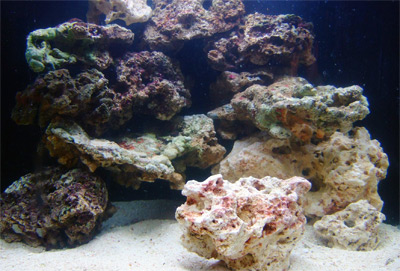Once hobby newcomers learn what live rock is and all the benefits it can provide in marine aquariums, the next big question they invariably ask is, “How much of it do I need for my tank?” More experienced fellow hobbyists, eager to be of help, typically respond with a pat answer along the lines of “somewhere between one and one-and-a-half pounds per gallon.”
While this type of formula is certainly convenient and eliminates guesswork, it unfortunately fails to address several key factors that must be considered when determining how much rock is actually appropriate for a given system. Here are just a few of them:
Differing density
Pound for pound, not all live rock stacks up the same. The density of live rock can vary considerably from one type/collection locale to another—and a highly porous rock is going to be significantly lighter than a very dense rock of the same size. (Visualize holding a chunk of lava rock in one hand and an identically sized chunk of granite in the other, and you’ll have the idea.) So, you can expect 100 pounds of highly porous rock to take up a lot more space in your tank than 100 pounds of dense rock will.
Livestock objectives
How much rock you’ll want to place in your tank will also vary based on your objectives for the system. For example, a full-blown reef tank might require more rock than a fish-only system to ensure there’s an adequate foundation for the various invertebrates you plan to keep. On the other hand, if your objective is a fish-only system and you plan to use live rock primarily for biofiltration, you can probably get by with less.
You also have to consider the unique needs of the different species you’ll be housing. Will the fish need a lot of open swimming space, or will they be better off with lots of nooks and crannies for hiding? Will any of them be burrowers that need an open plot of substrate? Will your invertebrate population include any corals that are best placed down on a sandy substrate rather than up on the rocks, such as Fungia, Catalaphyllia, or Trachyphyllia? In general, will you stock your tank lightly, heavily, or somewhere in between? All of these factors will have at least some bearing on how much live rock is appropriate for your tank.
Skimming and water-change regimen
Of course, if you do a really good job of removing dissolved organic compounds from your system before they have a chance to decompose and contribute to the bioload—via vigorous protein skimming, regular partial water changes, etc.—you may not need as much live rock for biofiltration purposes.
Potential use of non-live rock
Aquascaping does not have to be achieved entirely with expensive live rock. Many hobbyists choose to use base rock as a foundation for their rockwork and then top it with choice pieces of live rock in an effort to contain costs.
What am I forgetting?
As always, I’m sure I’ve overlooked some important points here. So, fellow salties, if you can think of any other factors that influence how much live rock one should purchase, please share them in the comment section below.



